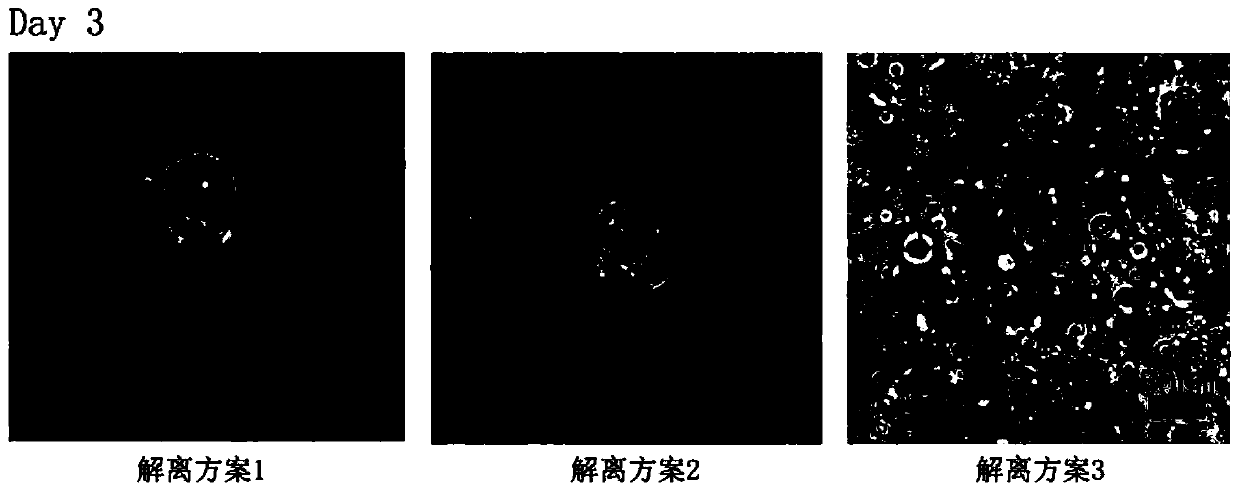In vitro culture method of cancer type organs
An in vitro culture and organ technology, applied in the field of cell engineering, can solve the problems of low enzymatic hydrolysis efficiency, easy contamination of samples, and inability to subculture for a long time, so as to improve enzymatic hydrolysis efficiency and maintain cell viability
- Summary
- Abstract
- Description
- Claims
- Application Information
AI Technical Summary
Problems solved by technology
Method used
Image
Examples
Embodiment 1
[0055] This example aims to explore the best solution for sample digestion, and cut the colon adenocarcinoma sample into 1-2mm 3 Small pieces, randomly divided into 3 parts, corresponding to the following 3 digestion schemes for the above enzymatic digestion process:
[0056] (1) Collagenase type I 75u / mL+Dispase 0.6u / mL;
[0057] (2) Collagenase type I 255u / mL+Dispase 0.6u / mL;
[0058] (3) Collagenase type I 255u / mL.
[0059] After the digestion, cultured according to the above culture process for 3 days. It was found that the solution (2) would cause many vacuoles and apoptosis in the cells, and the solution (3) would lead to a decrease in cell viability, and the dissociated cells did not reunite. , the organoid formation rate decreased, and only scheme (1) obtained better cell viability and could form organoids smoothly. Such as figure 1 shown.
Embodiment 2
[0061] In this plan, the purpose is to explore the best plan for sample cleaning, and 10 samples are selected to be treated with washing buffer in different orders.
[0062] 10 cases in the control group:
[0063] 1) Perform the second washing treatment on the fresh tumor samples in the washing buffer, that is, wash the fresh tumor samples in the washing buffer 1 for 5 or 6 times, each time for 4-6 minutes; Wash in Washing Buffer 2 for 2-4 minutes; wash the tissue washed in Washing Buffer 2 in Washing Buffer 3 for 2-4 minutes; wash the tissue washed in Washing Buffer 3 in Washing Buffer 4 at 4 Soaking for 28-32 minutes under the condition of ℃; and washing the tissue soaked in the washing buffer 4 in the washing buffer 5 for 5 or 6 times, each time for 4-6 minutes.
[0064]2) Excluding the samples after the first cleaning treatment, so as to remove fat, blood, necrosis and tissues with a content of interstitium greater than 20%;
[0065] 3) Perform the first cleaning treatme...
Embodiment 3
[0070] In this protocol, we aim to explore the best protocol for cell culture, and use colon adenocarcinoma organoid samples to investigate the effects of common components of the prior art medium on the growth of organoids.
[0071] The specific protocol is as follows: count the organoids, use Matrigel to resuspend the organoids according to the concentration of 10 μL / 50 organoids, plant them in a 96-well plate, 10 μL / well, and use the culture method minus different single components after seeding the plate. After 5 days of culture, the growth pictures were recorded and the effects of different medium conditions on the growth of organoids were quantitatively detected.
[0072] It was found that complete medium (including 10mM HEPES, 2mM L-Glutamine, 50ng / mLEGF, 100ng / mLNoggin, 500ng / mLLR-Spondin 1, 100ng / mLWNT-3A, 10ng / mL FGF-10, 0.5μM A83-01, 5uMSB202190, 4mM Nicotinamide and 10μM Y27632 in DMEM / F-12K medium), Noggin, A83-01, EGF and Y27632 components can promote the growth ...
PUM
 Login to View More
Login to View More Abstract
Description
Claims
Application Information
 Login to View More
Login to View More - R&D
- Intellectual Property
- Life Sciences
- Materials
- Tech Scout
- Unparalleled Data Quality
- Higher Quality Content
- 60% Fewer Hallucinations
Browse by: Latest US Patents, China's latest patents, Technical Efficacy Thesaurus, Application Domain, Technology Topic, Popular Technical Reports.
© 2025 PatSnap. All rights reserved.Legal|Privacy policy|Modern Slavery Act Transparency Statement|Sitemap|About US| Contact US: help@patsnap.com



